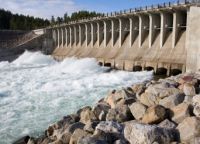

The UK is planning to generate renewable energy from the world's very first tidal lagoons, four of which will be in Wales and one each in Somerset and Cumbria.
A scheme in Swansea, worth £1bn, is already in the planning system and would be capable of producing enough energy to power 155,000 homes. Although the cost of generating power from the Swansea project will be high, the firm behind the plan says that further lagoons would generate electricity for less.
The lagoons will work in a similar way to a lock gate. When the tide rises, gates in a large purpose built sea wall will close causing water to build up behind it. Eventually, the gates will be opened to allow water to rush past turbines to fill up the lagoon. Then, when the tide goes out, the gates will be shut to hold the water inside the lagoon. Finally, at low tide, the gates will be opened again to generate power from the raised water level in the lagoon.
However, establishing the lagoons will require a huge engineering project. For example, the proposed scheme at Swansea will see the construction of a sea wall which will be more than five miles long and will go more than two miles out to sea at its furthest point. In addition, there are some concerns as to the impact that such lagoons would have on the natural environment, particularly when it comes to migratory fish.
Should all six lagoons go ahead, it is estimated that they will generate 8% of the UK's electricity from an investment of £12bn.